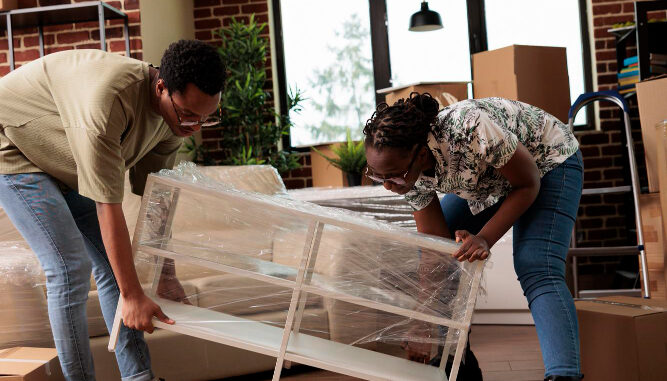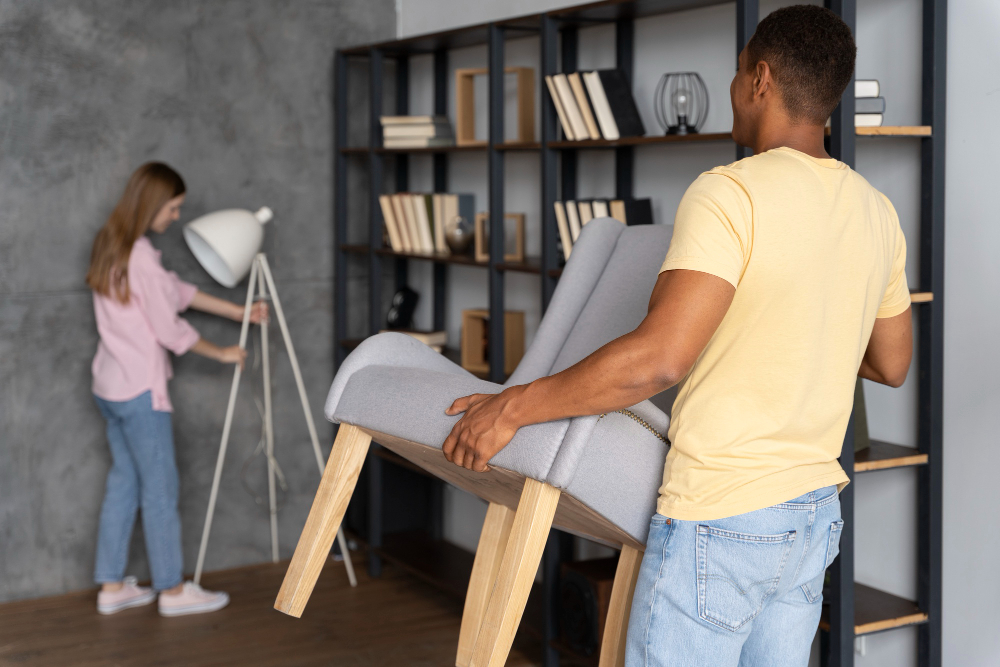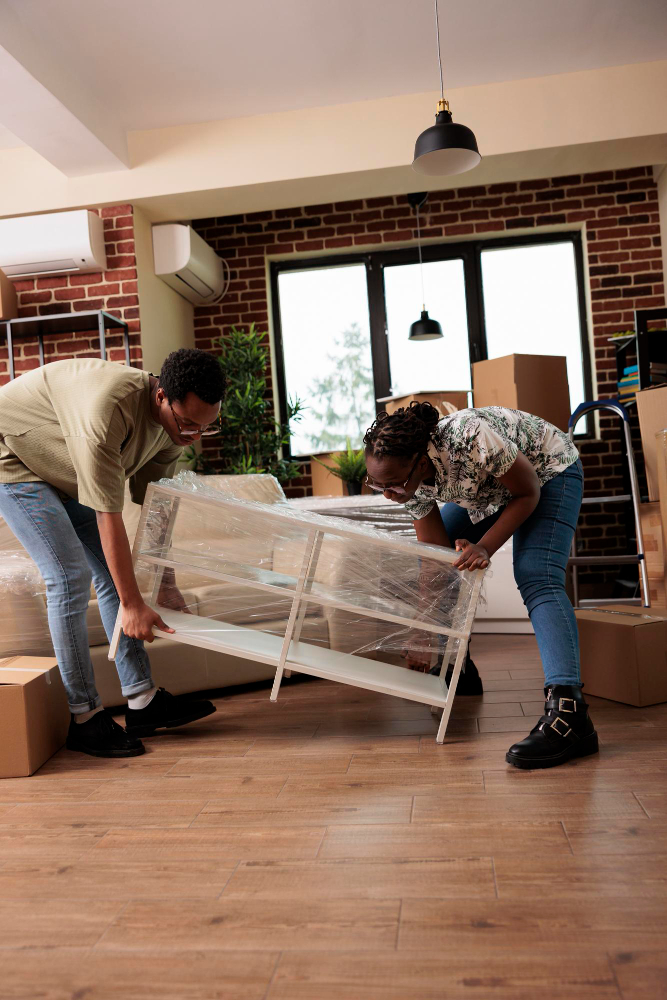
What to do with furniture when getting new flooring is a common issue faced by homeowners embarking on home improvement projects. The question of whether do flooring installers move furniture or if homeowners need to find an alternative solution themselves can be a significant part of the planning process.
This detailed how-to guide will walk you through each step necessary to manage your furniture effectively when getting new flooring, ensuring a smooth and efficient transition.
Table of Contents
1. Assessing your space and furniture needs
Initiating your home improvement project starts with a critical assessment of the rooms set for new flooring and the furniture within those spaces. Begin by creating a detailed inventory, noting every piece of furniture, its dimensions, and its significance to the room’s overall function and aesthetics.
This step is not just about understanding what you own but about making strategic decisions regarding the future of each piece.
Examine the size, weight, and delicacy of your furnishings to gauge the best approach for temporary relocation. Larger, heavier items may require special considerations for moving and storage, while fragile pieces need careful handling to prevent damage. This process also presents a perfect opportunity to reevaluate your possessions.
As you catalog your items, consider their necessity, emotional value, and fit within the revamped space. It’s an opportune moment to declutter, possibly letting go of items that no longer serve a purpose or enhance your living environment. This might mean donating to charity, selling items, or recycling pieces that are beyond use.
Moreover, this assessment phase allows you to envision the layout and functionality of your rooms post-installation. Reflect on how each piece contributes to the space and whether alterations in your furniture arrangement could optimize room flow or usability.
Think about the future, imagining how your new flooring will interact with your furniture, potentially inspiring a fresh design perspective or necessitating protective measures for both old and cherished pieces during the move.
2. Preparing your furniture for flooring installation

As you transition into the preparation phase for your new flooring installation, attention now turns to getting your furniture ready for the process. The initial task involves thoroughly cleaning each piece. This step is crucial as it prevents the spread of dust and debris, ensuring your living spaces remain clean during the transition.
Following cleaning, examine your furniture to determine which items can be disassembled. Taking apart larger or more cumbersome pieces not only facilitates easier handling but also significantly minimizes the risk of damage during the move. If you’re unsure about how to properly disassemble certain items, consult the manufacturer’s instructions or consider seeking professional help to avoid any mishaps.
Once disassembled, the next step is to wrap and protect your furniture. Utilize moving blankets, bubble wrap, or even old blankets to cover each piece. Special attention should be given to fragile items and those with sharp edges or corners that could potentially gouge or scratch your flooring surfaces, whether they be the old ones being removed or the new ones being installed.
Determining an appropriate storage location for your furniture during the installation is another critical component of the preparation process. The chosen spot should be secure and out of the way to avoid interference with the installation work.
Options might include a spare room, basement, garage, rented storage unit, or a portable storage container on your property. The selection largely depends on the size of your furniture, the extent of the installation work, and how long the project is expected to take.
3. Protecting your new flooring from furniture damage
Upon the joyous completion of your new flooring installation, the spotlight shifts to safeguarding this significant investment from any potential furniture-induced harm. The key to maintaining the pristine condition and longevity of your flooring lies in preemptive and thoughtful measures before reintroducing furniture to the space.
A critical step involves outfitting the feet or bases of tables, chairs, sofas, and other substantial furniture pieces with felt pads. This simple yet effective strategy can drastically reduce the risk of scratches and dents that could mar your new floors.
For areas of your home that witness considerable foot traffic, contemplate the strategic placement of area rugs or floor mats. These can serve dual purposes: adding a layer of decor to your home while acting as a protective barrier for your floors, mitigating the wear and tear in these high-traffic zones.
The method in which furniture is moved back into the room is equally paramount. To prevent any unintended damage, bypass the temptation to drag furniture across your new flooring. Instead, employ furniture sliders that allow for smooth, frictionless movement across the surface or, better yet, assemble an adequate number of helpers to lift and place furniture in its designated spot with precision. This ensures not only the safety of your new flooring but also the integrity of your furniture.
Adhering to these proactive steps before the furniture makes its return not only shields your flooring from potential damage but also contributes to the overall aesthetic and longevity of your home’s new look.
4. Use professional movers
Instead of moving furniture yourself, you can engage professional movers presents a plethora of advantages, particularly when faced with the intricate task of relocating furniture during flooring upgrades. These skilled experts bring a wealth of knowledge and a suite of specialized tools designed to handle items of any size or complexity with utmost care.
This becomes especially crucial for homeowners who possess heavy, oversized, or delicate pieces that demand a nuanced approach to prevent damage during the moving process.
One of the standout benefits of employing professional movers is their proficiency in the disassembly and reassembly of furniture. This capability not only ensures the safe transportation of your belongings but also significantly expedites the entire moving process.
With their expertise, what might take a homeowner hours to figure out, professional movers can accomplish in a fraction of the time, thereby streamlining the transition and allowing the flooring project to progress more efficiently.
Another critical advantage is the mitigation of physical strain on homeowners. The process of moving furniture, particularly in the context of preparing for and following up on flooring installation, can be physically demanding.
By delegating this responsibility to professionals, homeowners are spared from the heavy lifting and the potential injuries that could arise from moving large furniture. This aspect is particularly beneficial for those with physical limitations or who prefer to avoid the risk of personal injury.
In choosing to partner with professional movers, homeowners gain the peace of mind that comes from knowing their belongings are handled with professionalism and care. This allows for a focus on the excitement of the flooring upgrade, rather than the stress of moving logistics.
5. Returning furniture to your newly floored rooms

Bringing furniture back into your rooms after new flooring has been installed requires careful consideration to ensure both the safety of the flooring and the effective layout of your space. Start by revisiting the initial assessment of your furniture and room. Utilize any floor plans or photos you created as a roadmap for where each piece should be positioned. This foresight in planning aids significantly in visualizing the end result and executing the placement efficiently.
Kick off the process by moving the largest pieces into place first. These are typically your sofas, beds, and wardrobes. Their placement is crucial as they often dictate the flow and functionality of the room. By establishing these key pieces first, you create a framework around which the smaller items can be organized.
Next, begin reintroducing the smaller items. During this phase, consider the harmony and balance within the room. Are the walking paths clear and logical? Does the placement of each piece contribute to a cohesive aesthetic and practical use of the space? This step is also an excellent opportunity to reassess each item’s relevance in your newly floored room. It might be the right moment to rethink the positioning or even the necessity of certain pieces.
As you settle each piece into its new or former place, remember to reapply any felt pads or sliders to the bottoms of furniture. This crucial step prevents scratches and damage to your new flooring, ensuring its longevity and maintaining its appearance.
Leave a Reply